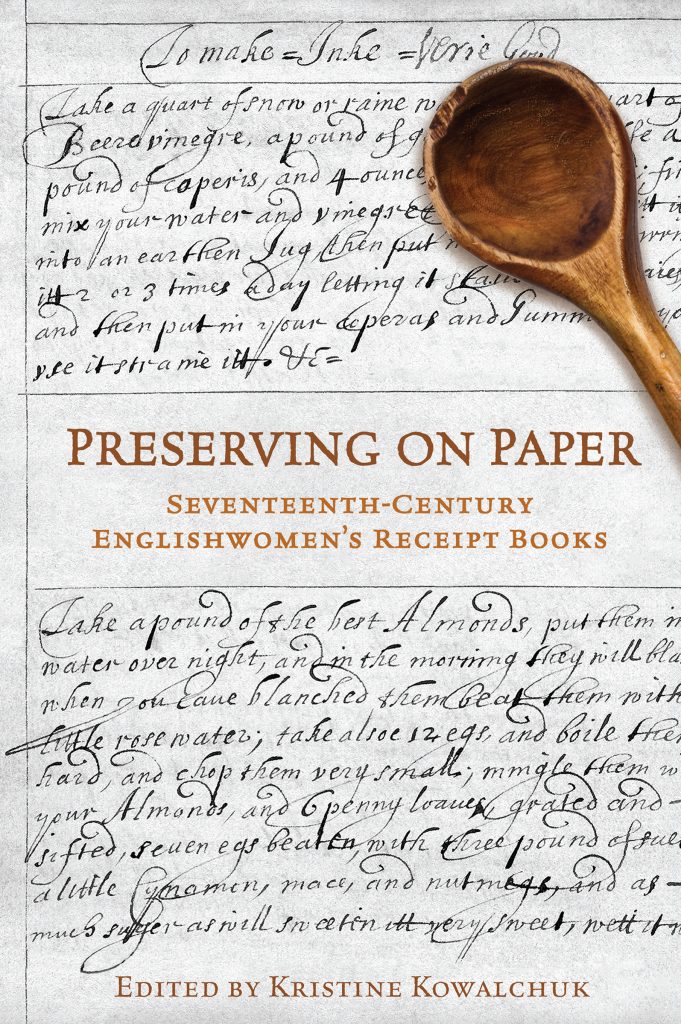Kristine Kowalchuk’s Preserving on Paper: Seventeenth-Century Englishwomen’s Receipt Books is a fascinating exploration of domestic knowledge, food culture, and women’s intellectual contributions in early modern England. This meticulously edited volume brings together three previously unpublished manuscript receipt books, offering readers a rare glimpse into the lives of seventeenth-century Englishwomen through their handwritten recipes, medical remedies, and household management tips.

Kristine Kowalchuk is a published author, critical thinking and ethics instructor at NAIT, and an adjunct professor at the University of Alberta’s Faculty of English and Film Studies. Her research explores food and ecology through an ecofeminist and anticolonial lens. She founded and chairs the Edmonton River Valley Conservation Coalition, advocating for the North Saskatchewan River Valley’s protection, and serves as board chair of Food for Thought, a school food program feeding 550 students daily while promoting food literacy. As Environment Critic, she champions systemic solutions for Alberta’s transition to a diverse, land-conscious economy rooted in reciprocity and sustainability.

What makes this collection so compelling is its illumination of how women preserved and passed down knowledge in a time when their voices were often marginalized in print culture. These receipt books were more than simple cookbooks; they were practical guides to survival, containing remedies for ailments, food preservation techniques, and even beauty treatments. Kowalchuk’s introduction provides rich historical context, explaining the significance of these manuscripts as both personal and communal records of knowledge-sharing among women.
The receipts or recipes take on an interesting theme. Nose-to-tail cooking may seem new to us, but when food was scarce, this culinary philosophy ensured the next meal. There’s a recipe for cooking a calf’s head or stewing a whole carp. Medicines are also explored with remedies for everything from powder for a woman in labour and beef marrow ointment.

There is a recipe for “Picadillo with Leg of Lamb” which was interesting: “First prick the meat and then wash it well and then put it into a frying pan, lightly boil it with water, salt and some minced garlic. Once cooked al dente, remove the meat and pound it in a metal mortar, and keep pounding it, for if any nerve appears in the meat as a result of poor chopping, in this way it is easy to get rid of it. Then put it into a cooking pan with pork grease and add the spices (nutmeg, saffron, cinnamon, cloves and pepper). Before taking it out to carry to the table, beat a few egg yolks and eggs with lime juice, pour everything into the pot and stir it all and thus carry this plate of picadillo to the table.” We thought you’d like to try an updated version of Lamb Picadillo in our Recipe section.
The editor’s careful transcription and insightful annotations make the text accessible while preserving the original language and spellings, allowing modern readers to appreciate the authenticity of these historical documents. Each receipt book reveals a complex world of domestic expertise, where culinary skills intersected with early medical practices. The entries also reflect the global influences of the period, with ingredients like spices and sugar hinting at England’s growing colonial trade.

One of the most striking aspects of Preserving on Paper is how it challenges traditional narratives of knowledge production. While male scientists and physicians dominated formal medical discourse, women were actively engaged in empirical learning through their receipt books, experimenting with cures and treatments based on generations of experience. Purchase a copy of this book at https://utppublishing.com/doi/book/10.3138/9781487520038 or win this historical insight into 17th century kitchens in our Giveaway section.
For historians, food enthusiasts, and anyone interested in women’s history, Preserving on Paper is a must-read. Kowalchuk’s work not only revives these long-overlooked texts but also highlights the intellectual and practical contributions of early modern women in shaping household and medical knowledge.
Contents and images used with permission by University of Toronto Press. https://utppublishing.com/doi/book/10.3138/9781487520038


